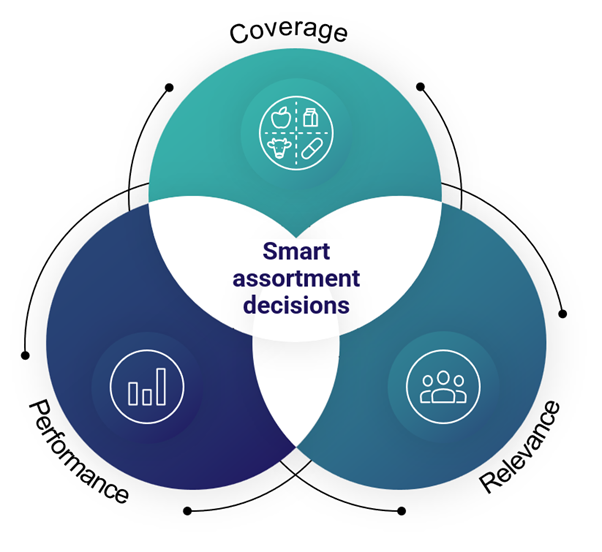How to overcome assortment challenges? Lessons from history
Retail has always been a story of evolution, adaptation, and innovation. Each era brought its own challenges, and those who found effective solutions helped shape the future of the industry. There are some fundamental pillars, and among them, assortment deserves special attention, as it has always been at the heart of major transformations in retail.
Let’s take a journey through time and understand how past learnings can help us tackle today’s challenges.
The evolution of assortment: a timeline

- The beginning of the Barter System: limited supply
Imagine a world without money. In 9,000 B.C., direct bartering of goods was the primary form of transaction. But this system had a major challenge: how to determine a fair value for different products? If I produce wheat and you have fish, how do we know how many kilos of wheat equal one fish? And if you needed wheat but I didn’t want fish, the negotiation became impossible.
Solution: This difficulty led to the invention of money, a resource that provided uniform value to products and allowed trade to grow beyond direct exchanges, enabling access to a more diverse assortment. - Greek agoras: the first product assortment
In Ancient Greece, agoras emerged as commercial centers offering a wide variety of goods. However, the product supply was still limited to local production and the seasons, making the product mix unstable.
Solution: The development of trade routes enabled products from different regions to be exchanged, marking the early beginning of product mix management in retail. - Medieval markets and fairs: ensuring consistency
As fairs and markets grew, so did the product variety, but availability remained uncertain. A bad harvest or trade barriers could make certain items disappear from the market, affecting consumers.
Solution: Merchant guilds standardized production and regulated trade, ensuring a more predictable and reliable assortment. - Mom and Pop stores: personalized but limited assortment
In the 19th century, small shopkeepers knew their customers well and offered products according to their preferences. However, their ability to diversify was restricted, as they relied on a few suppliers and had limited storage space.
Solution: The rise of chain stores allowed for greater product diversification, centralized inventories, and cost reduction, ensuring a broader mix. - Self-service: expanded mix and customer choice
With the introduction of self-service in 1916 by Piggly Wiggly in Memphis, Tennessee, customers began selecting their own products, increasing the need for a well-planned assortment.
Solution: Product categorization and shelf space management became strategic, optimizing the arrangement of the product mix. - Supermarkets and big box stores: balancing assortment and efficiency
The shift to supermarkets and large-format stores significantly increased the available assortment but brought challenges like over-variety and high logistical costs.
Solution: The use of data and direct supplier negotiations enabled strategic assortment management, balancing variety, space, and profitability. - E-commerce: unlimited assortment with challenges
The digital revolution allowed for an almost infinite assortment, removing the physical barriers of stores. However, it created new challenges, such as product curation and inventory management. Moreover, with the convergence of physical and digital retail, a cohesive product mix across channels became essential.
Solution: Personalization of the customer experience helped create an efficient product mix, ensuring a relevant and attractive offering.
What about today? Customers demand experience and personalization
In the past, the main challenge was simply ensuring product availability. Today, the reality is very different.
Customers have changed. They don’t just want to find a product — they want all their needs met. They seek convenience, personalization, and purpose. They are more informed, more demanding, and less loyal to brands. The shopping experience has become as important as the product itself.
At the same time, the economic landscape presents complex challenges. Inflation impacts purchasing power, pushing consumers to prioritize prices and promotions. Supply chains remain unstable, affected by factors like geopolitical shifts, currency fluctuations, and global logistics crises. In this environment, retailers face a dilemma. An excessive assortment can lead to high costs, waste, and loss of operational efficiency. On the other hand, a limited offering may result in customer frustration and lost sales to competitors.
How can we balance increasingly demanding consumers with an increasingly complex market?
The truth is, these forces can be balanced — and the key lies in using data and technology to make smarter decisions. How retailers do this may define their survival and success in the market.
What have we learned?
Looking at the evolution of retail, it’s clear that the challenges aren’t new — but the tools to face them have evolved. What can we learn from this journey? Each era had its own challenges, but three factors were crucial in overcoming them:
- Creativity: Retail has always needed to reinvent itself. Major changes stemmed from innovative ideas. From facilitating trade in Ancient Greece to creating self-service in supermarkets, innovation has always been the key to overcoming challenges.
- Adaptation: Customer behavior has never been static. When customers started seeking convenience, self-service gained traction. When they wanted more personalized experiences, digital exploded. Those who didn’t adapt were left behind.
- Technology: Every major advancement in retail has been linked to technology — from the invention of money to barcodes, from CRM to artificial intelligence. And this journey is far from over.

Smart assortment decisions, supported by technology
If technology has always driven retail, today its true power lies in how it helps us understand and interpret customer data, transforming insights into strategic actions. And considering that an efficient assortment must respect the triad of coverage, performance, and relevance, technology becomes essential in each of these dimensions, ensuring more accurate decisions.
- Coverage
In the past, Mom-and-Pop stores knew their customers well and stocked products based on direct knowledge of their needs. Today, retailers can scale this customer knowledge: data analysis ensures that the diverse needs of consumers are met. Machine learning algorithms analyze purchase patterns, seasonality, and behavior to suggest the ideal mix for each store profile and region. - Performance
From medieval guilds to large retail chains, the performance of each item has always been critical. But performance isn’t just about volume and revenue. It’s essential to consider product distribution across different channels, ensuring presence where it has the greatest sales potential. Additionally, specific indicators for loyal customers help identify which items truly drive engagement and repeat purchases, enabling a more effective strategy to maximize long-term value. - Relevance
Physical retail has always benefited from local knowledge. Merchants knew what their customers needed. Now, AI and digital personalization take this to the next level. Algorithms recommend products based on purchase history, location, and customer preferences, ensuring relevance for every profile.

From the markets of Ancient Greece to artificial intelligence in modern retail, evolution has always been in the hands of those who could see beyond. At the heart of this transformation are data, technology, and the ability to interpret consumer needs.
The future of retail won’t be defined by the biggest players, but by those who can turn information into action and strategy into experience. And this story is still being written. The question is: Who will lead the next chapter?
Sources:
https://metrobi.com/blog/the-history-of-retail-a-timeline/
https://www.lightspeedhq.com/blog/the-history-of-retail-a-timeline/
https://www.boweryboyshistory.com/2020/11/a-grocery-story-americas-first-supermarket-opens-in-queens-1930.html
https://www.linkedin.com/pulse/evolution-retail-united-states-from-corner-stores-david-happe-80bke/
https://medium.com/bartersmartplace/the-history-of-trade-and-the-role-of-barter-system-5d4a7b37cfb2
TOPICS
RELATED PRODUCTS
Amplify Customer understanding to create strategies that drive results
Customer First solutionsThe latest insights from our experts around the world
Unlocking success: why agency planning teams should get Tesco retail media certified
Smart Retail: AI cheat sheet for retail execs
How do retailers integrate one loyalty programme into another?




